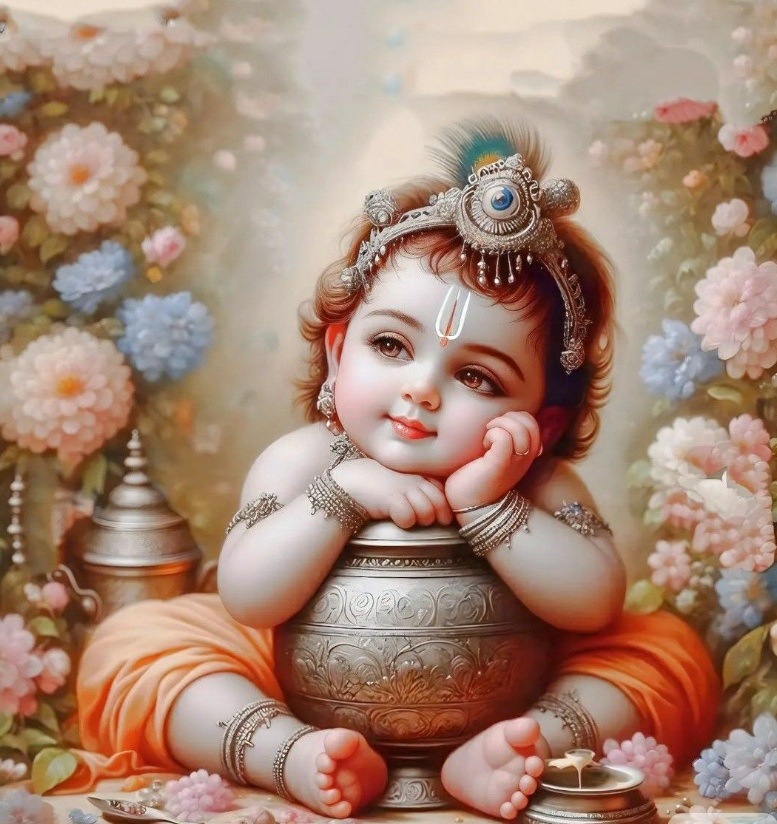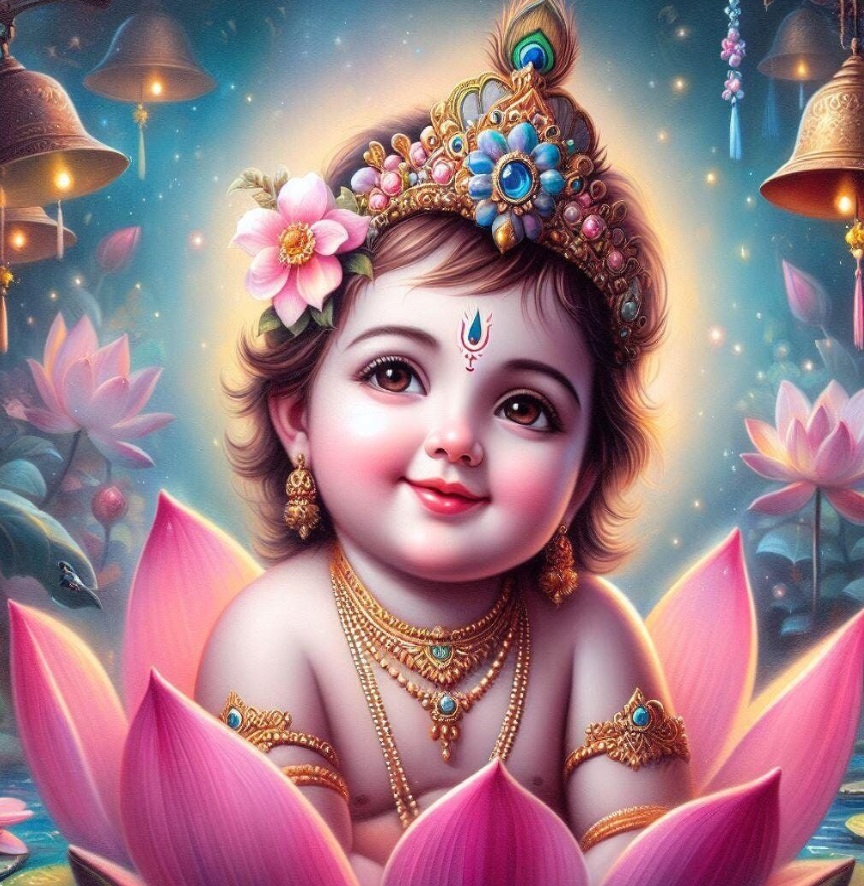Official Website : https://divinenewz.com/
Janmashtami is celebrated to commemorate the birth of Lord Krishna, who is revered as the eighth avatar of Lord Vishnu in Hinduism. It’s a major festival observed with great joy and devotion across India and among Hindus worldwide.
1. INTRODUCTION
Janmashtami, also known as Krishna Janmashtami, Gokulashtami, or Sri Krishna Jayanti, is a significant Hindu festival celebrated across India and by Hindus worldwide. It commemorates the birth of Lord Krishna, the eighth avatar of Lord Vishnu, who is revered as one of the most powerful deities in the Hindu pantheon. Celebrated with intense devotion, elaborate rituals, fasting, and cultural festivities, Janmashtami falls on the Ashtami (eighth day) of the Krishna Paksha (waning moon) in the Hindu month of Bhadrapada (August–September).
The birth of Krishna marks not only a religious milestone but a deep spiritual event, symbolizing the descent of the Divine into the material world to restore dharma (righteousness) and destroy adharma (unrighteousness). This festival brings together mythological richness, spiritual insights, and devotional fervor, making it one of the most revered celebrations in Hinduism.
2. MEANING OF JANAMASHTAMI
Janmashtami, also known as Krishna Janmashtami, is a major Hindu festival that celebrates the birth of Lord Krishna, the eighth avatar (incarnation) of Lord Vishnu.
The term Janmashtami comes from two Sanskrit words:
The festival is observed on the eighth day (Ashtami) of the Krishna Paksha (the dark fortnight of the lunar month) in the month of Bhadrapada according to the Hindu calendar, which usually falls in August or September in the Gregorian calendar
Janmashtami holds deep spiritual and cultural importance in Hinduism. Lord Krishna’s birth is believed to have taken place more than 5,000 years ago in Mathura, in a prison cell, under extraordinary circumstances to destroy evil and restore dharma (righteousness) on Earth. Devotees observe this day with fasting, devotional singing, reciting scriptures like the Bhagavad Gita and Bhagavatam, enacting scenes from Krishna’s childhood (Rasa Lila and Krishna Leela), and visiting temples beautifully decorated for the occasion.
The festival symbolizes the victory of good over evil, the power of divine love, and the importance of devotion and righteousness in life. For millions of devotees, Janmashtami is not just a historical commemoration but also a personal spiritual opportunity to remember, worship, and connect with Lord Krishna.
3. THE SPIRITUAL CONTEXT OF JANAMASHTAMI
Lord Krishna is revered as the eighth incarnation (avatar) of Lord Vishnu, the preserver in the Hindu Trinity (Trimurti). His birth was not an ordinary event but a divine occurrence meant to restore balance to the world. Hindu scriptures such as the Bhagavata Purana, Mahabharata, and Harivamsa describe in detail the circumstances leading to his incarnation.
At the time of
Krishna’s birth, the
Earth was burdened by excessive sin, injustice, and cruelty. The demon king Kansa, ruler of Mathura, was a primary source of this oppression.
A divine prophecy declared that the eighth son of his sister Devaki would be his destroyer. To prevent this,
Kansa imprisoned Devaki and her husband Vasudeva, killing each of their first six children.
The
seventh child, Balarama, was mystically transferred to the womb of Rohini (another wife of Vasudeva), and the eighth child, Krishna, was born at midnight under miraculous conditions.
Janmashtami marks this divine event — the arrival of the Supreme Being in human form to annihilate evil and re-establish dharma (righteousness).
4. ETMOLOGY AND DEEPER MEANING
- Janma (birth) :
Represents the
appearance of divine consciousness into the material world. In the spiritual sense, Krishna’s birth symbolizes the
awakening of divine love and wisdom in the heart of a devotee.
- Ashtami (eighth day) :
In Vedic numerology, the number
eight represents infinity, cycles of creation and dissolution, and transcendence beyond material limitations. The
eighth day is also astrologically significant for the appearance of divine energies.
Thus, Janmashtami is not only about a historical birth but also about the timeless descent (avatarana) of the Supreme to guide humanity.
5. MYTHOLOGICAL SIGNIFICANCE
According to sacred texts, the night of Krishna’s birth was filled with supernatural signs:
- The
prison gates opened on their own.
- The guards fell into a
deep sleep.
- The
Yamuna River parted to allow Vasudeva to carry infant Krishna to safety in Gokul.
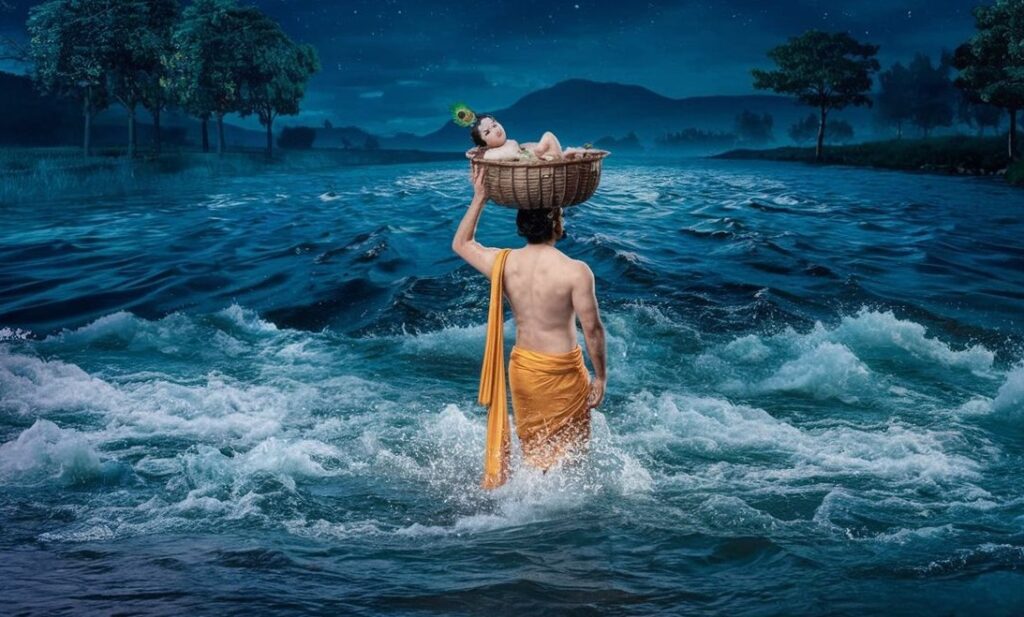
Krishna was
raised by Nanda and Yashoda in Gokul, away from the evil eyes of Kansa. His childhood stories —
stealing butter (Makhan Chor), playing the flute, lifting Govardhan Hill, and performing the Rasa Lila with the Gopis — are treasured episodes in Hindu devotional literature.
The festival therefore celebrates both his
divine mission (destroying evil) and his divine playfulness (leelas) that enchant the hearts of devotees.
6. RELIGIOUS SIGNIFICANCE
In Hinduism,
Krishna is not just a deity but also a friend, lover, philosopher, and guide. He is the
speaker of the Bhagavad Gita, one of the most important scriptures in Hindu philosophy.
His teachings emphasize devotion (bhakti), duty (karma), and knowledge (jnana).
Janmashtami is a reminder that whenever injustice becomes unbearable, the Divine will manifest to protect the good and eliminate the wicked. This principle is expressed in Bhagavad Gita (Chapter 4, Verse 7–8):
Abhyutthanam adharmasya tadatmanam srijamy aham
Paritranaya sadhunam vinasaya ca duskrtam
Dharma-samsthapanarthaya sambhavami yuge yuge”
Translation:
“Whenever there is a decline in righteousness and an increase in unrighteousness, O Arjuna, at that time I manifest Myself. To protect the righteous, to annihilate the wicked, and to re-establish the principles of dharma, I appear in every age.”
7. CULTURAL SIGNIFICANCE
The festival is celebrated with immense enthusiasm across India and among Hindu communities worldwide. While the spiritual essence remains the same, cultural expressions vary by region.
- Mathura and Vrindavan:
The birthplace and childhood playground of Krishna witness grand celebrations with devotional singing, reenactments of
Krishna’s life (Ras Lila), and processions.
- Maharashtra:
The famous
Dahi Handi event symbolizes Krishna’s playful butter theft, where human pyramids attempt to break a pot of curd hung high above the ground.
- Gujarat:
Devotees perform
Garba and Dandiya Raas dances in Krishna’s honor.
- South India:
Homes are decorated with
tiny footprints drawn from the entrance to the prayer room, symbolizing Krishna’s arrival.
- Northeast India (Manipur, Assam): :
The festival includes cultural dance-dramas portraying Krishna’s divine love with Radha and the Gopis.
8. RITUALS AND OBSERVANCES
Janmashtami rituals are designed to honor Krishna’s birth both in a ceremonial and personal way:
- Fasting (Upavasa) –
Devotees observe a full-day fast, breaking it only at midnight when Krishna is believed to have been born.
- Midnight Celebration –
Temples and homes hold a
special aarti at midnight, accompanied by
chanting of “Hare Krishna” and ringing of bells.
- Jhulan (Swing) Ceremony –
An idol of
baby Krishna is placed in a decorated cradle or swing and gently rocked by devotees.
- Abhishekam (Sacred Bath) –
The
idol is bathed in milk, honey, curd, ghee, and water, symbolizing purity and devotion.
- Recitation of Scriptures –
Verses from the
Bhagavad Gita and Bhagavata Purana narrating Krishna’s birth and life are read.
- Bhajans and Kirtans –
Devotional songs glorifying
Krishna’s name and deeds are sung throughout the day and night.
- Offering of Sweets –
Special prasad such as
Makhan, Mishri, Peda, and Panchamrit are prepared and offered to Krishna.
9. SYMBOLIC MEANING FOR DEVOTEES
Janmashtami is not merely a commemoration of a past event; it has deep personal meaning:
- Spiritual Birth –
Just as Krishna appeared in the
prison of Mathura, divine consciousness can be born in the “prison” of the human heart when it is cleansed through devotion and faith.
- Victory Over Ego –
Kansa represents the ego, fear, and material greed. Krishna’s victory over him symbolizes the triumph of the soul over lower tendencies.
- Faith in Divine Protection –
The miraculous events of Krishna’s birth remind devotees that the Divine will always provide protection in times of difficulty.
- Joy in Devotion –
Krishna’s life encourages
devotees to see spirituality not as a burden but as a joyful and loving relationship with God.
10. GLOBAL RELEVANCE
Beyond India, Janmashtami is celebrated in many countries with large Hindu populations such as Nepal, Bangladesh, Fiji, Mauritius, and Trinidad. The International Society for Lord Krishan Consciousness (ISKCON) also observes the festival worldwide with grand processions, chanting, and public feasts, spreading Krishna’s message of love and devotion across cultures.
The meaning of Janmashtami goes far beyond the celebration of a divine birth thousands of years ago. It represents the timeless truth that whenever humanity is engulfed in darkness, the Divine will manifest to guide, protect, and uplift. For devotees, it is an opportunity to renew their commitment to dharma, deepen their love for Lord Krishan, and allow the “birth” of divine joy within their own hearts.
As Lord Krishna’s flute calls the hearts of all beings, Janmashtami reminds us to listen to that divine melody, follow the path of righteousness, and live with love, compassion, and truth.
What I am talking about, everything is incomplete, if you do not understand who is Lord Krishan. Who is Lord Krishna? Now let me give you some introduction about who is Lord Krishna? his birth and some other details about him.
11. WHO IS LORD KRISHAN?
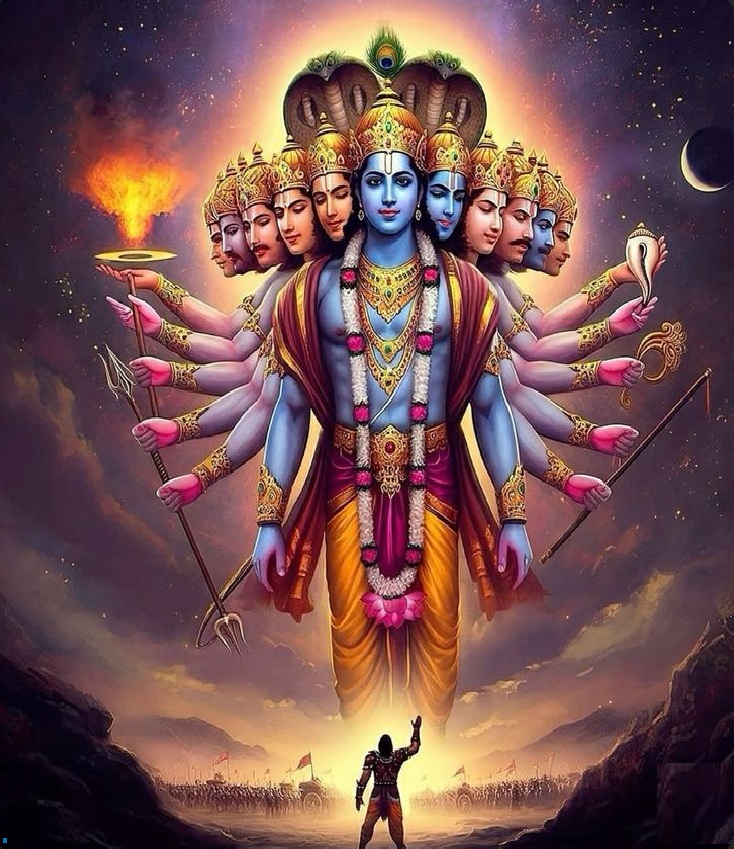
Lord Krishan is considered the Supreme Being in many Vaishnava traditions of Hinduism. He is the central character of the Mahabharata and the speaker of the Bhagavad Gita, which is among the most important spiritual scriptures. Krishna is known for his childhood pranks, divine miracles, love for Radha, and his role as a charioteer and counselor to Arjuna during the Mahabharata war.
He embodies love, compassion, wisdom, joy, and the power of truth. His life stories—referred to as
“Krishna Leela”are filled with profound teachings and philosophical truths, making him one of the most relatable and worshipped deities in Hinduism.
Lord Krishna is one of the most revered and widely worshipped deities in Hinduism.
His life, teachings, and divine play have captured the hearts and minds of millions for over five thousand years. Krishna is considered the
eighth avatar (incarnation) of Lord Vishnu, the
preserver in the Hindu Trinity (Trimurti) of Brahma (the creator), Vishnu (the preserver), and Shiva (the destroyer). Krishna is worshipped as the Supreme Personality of Godhead, especially by followers of the Vaishnava tradition. His divine roles encompass that of a
mischievous child, a charismatic youth, a profound philosopher, a compassionate friend, a fearless warrior, and a divine teacher.
12. BIRTH AND EARLY LIFE OF LORD KRISHAN
Lord Krishan was born over 5,000 years ago in the Dwapara Yuga in the
city of Mathura, in present-day
Uttar Pradesh, India. His parents were
Devaki and Vasudeva. At the time of his birth,
Mathura was ruled by the tyrant King Kansa, who was
Devaki’s brother. A prophecy foretold that Kansa would be killed by the eighth son of Devaki. Terrified, Kansa imprisoned
Devaki and Vasudeva and killed their first six children.
The
seventh child, Balarama, was mystically transferred to the womb of Rohini. When Krishna, the
eighth child, was born at midnight, miraculous events unfolded:
the prison doors opened, the guards fell asleep, and Vasudeva carried the infant across the Yamuna River to Gokul, where he was raised by foster parents,
Nanda Maharaj and Yashoda.
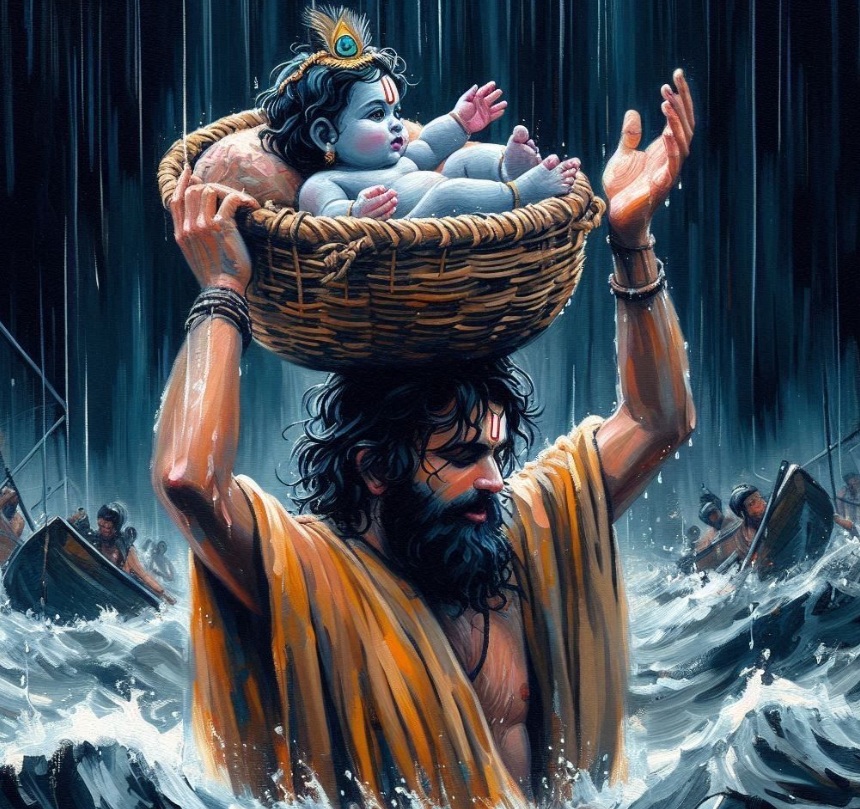
13. LORD KRISHAN’S CHILDHOOD AND YOUTH
Lord Krishan’s childhood is full of divine playfulness (leela) and miraculous acts. He is often depicted as a butter thief (Makhan Chor), stealing butter and sharing it with his friends. His pranks endeared him to the villagers of Gokul and Vrindavan.
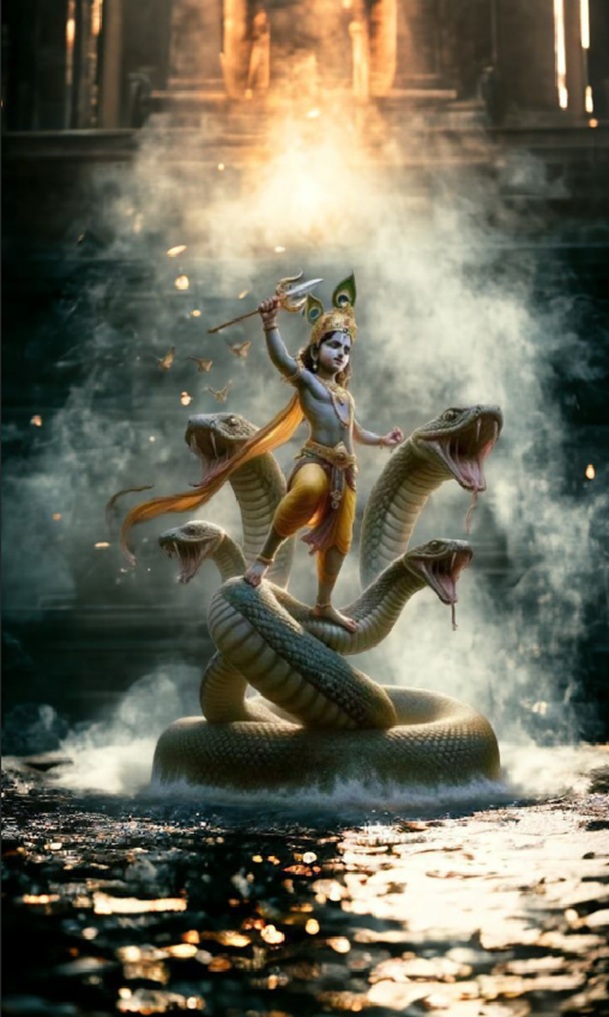
- Kaliya Mardana – He subdued the serpent
Kaliya who had poisoned the Yamuna River.
- Govardhan Leela –
Krishna lifted the Govardhan Hill on his little finger to
protect the villagers from torrential rains sent by Indra.
- Vanquishing Demons – Lord Krishan killed several demons sent by Kansa, including
Putana, Shakatasura, Trinavarta, and Keshi.
Lord Krishan’s youthful pastimes include his divine love with Radha and the Gopis. These stories symbolize the soul’s longing for the divine. The Ras Leela (circle dance) performed with the Gopis represents the eternal dance of love and devotion.
14. LORD KRISHAN IN THE MAHABRARATA
Lord Krishan played a
central role in the Indian epic Mahabharata. He was a
cousin and dear friend to the Pandavas, especially Arjuna. During the great war of Kurukshetra, Lord Krishan did not fight but became Arjuna’s charioteer and guide.
The Bhagavad Gita: Before the war began,
Arjuna was overcome with grief and moral confusion. Lord Krishan then revealed the sacred scripture known as the
Bhagavad Gita. In it, he taught profound spiritual principles, such as:
- Selfless action (Karma Yoga)
- Devotion (Bhakti Yoga)
- Knowledge and wisdom (Jnana Yoga)
- Detachment from results
- Seeing God in all beings
Through the Gita, Lord Krishan established himself not just as a warrior or kingmaker, but as a divine teacher and philosopher.
15. LORD KRISHAN’S ROLE AS A RULER AND STATESMAN
After defeating
Kansa and restoring peace in Mathura, Krishna migrated to Dwarka to avoid further attacks from Jarasandha, another powerful enemy. There, he established the kingdom of Dwarka and ruled as a wise and just king.
Lord Krishan was also a skilled diplomat and strategist. He played key roles in various episodes of the Mahabharata, including:
- Acting as a peace envoy between the
Kauravas and Pandavas.
- Protecting
Draupadi from humiliation during the game of dice.
- Assisting in the defeat of major enemies like
Shishupala and Duryodhana.
16. LORD KRISHAN’S FAMILY AND PERSONAL LIFE
Lord Krishan had many wives, among whom Rukmini, Satyabhama, and Jambavati are the most prominent. He had numerous sons and daughters. Despite his royal duties and family responsibilities, Krishna always remained detached and focused on the higher purpose of dharma.
His
relationship with Goddess Radha Rani, although not marital, holds the highest position in the realm of spiritual love. Their bond symbolizes the eternal connection between the individual soul and the Supreme Divine.
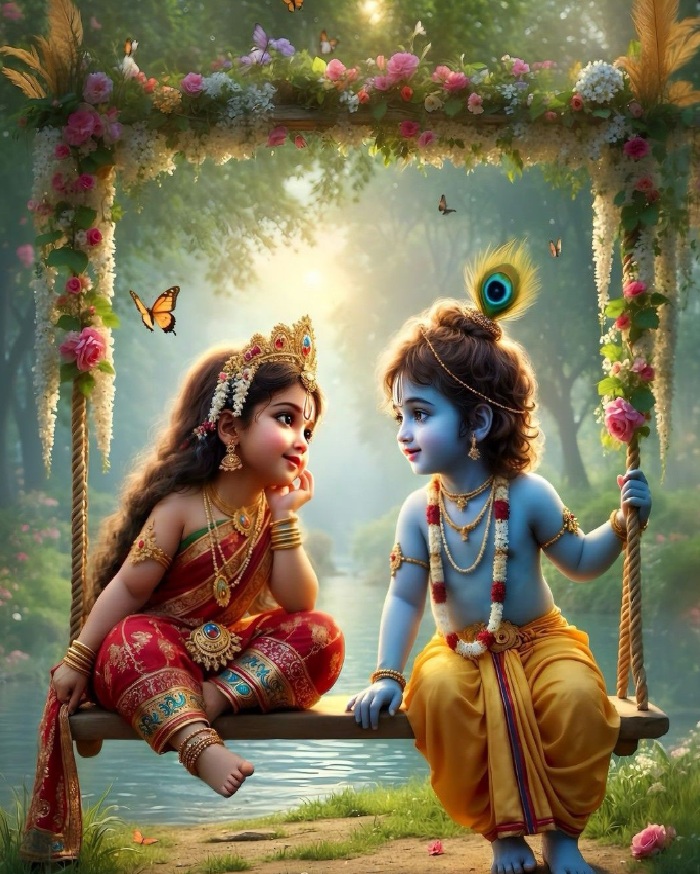
17. LORD KRISHAN’S DEPARTURE FROM EARTH
After the Mahabharata war, Lord Krishan lived for several years in Dwarka. Eventually, his mission on Earth was completed. A hunter named Jara accidentally shot Lord Krishan in the foot, mistaking him for a deer. This marked the end of Lord Krishan’s earthly presence and signaled the beginning of Kali Yuga, the present age of darkness and ignorance.
However, Lord Krishan’s death is not considered a tragedy. Like his birth, his departure was divine and planned. His life continues to inspire millions.
18. LORD KRISHAN IN SCRIPTURES AND LITERATURE
Krishna is mentioned in several sacred texts:
- Mahabharata – as a divine strategist and charioteer.
- Bhagavad Gita – as the
speaker of eternal wisdom.
- Bhagavata Purana (Srimad Bhagavatam) – narrates
Krishna’s childhood and youth.
- Vishnu Purana, Harivamsa, and Brahma Vaivarta Purana – provide details of his divine play.
Poets like Surdas, Meera Bai, Tulsidas, Jayadeva (Gita Govinda), and Chaitanya Mahaprabhu expressed their devotion through songs and poems glorifying Krishna.
19. SYMBOLISM AND PHILOSOPHY OF LORD KRISHAN
- Flute- Represents the
human heart emptied of ego, through which divine music (grace) flows.
- Peacock Feather – Symbolizes
beauty, knowledge, and spiritual magnificence.
- Butter and Curd – Signify
purity and the essence of devotion.
- Blue Color – Represents the
infinite sky and cosmic nature of Krishna.
Krishna’s teachings emphasize:
- Performing
one’s duty without attachment.
-
Loving all beings as manifestations of God.
-
Seeking God not just in rituals but in every act of life.
20. WORSHIP OF LORD KRISHAN TODAY
Lord Krishan is worshipped across India and worldwide. Major traditions include:
- Vaishnavism- Regards
Lord Krishan as the Supreme God.
- ISKCON (Hare Krishna Movement) – Promotes Krishna consciousness through mantra chanting.
- Bhakti Movement –
Saints like Meera Bai, Narsinh Mehta, and Tukaram focused on personal devotion to Krishna.
Major temples include:
21. FESTIVALS CELEBRATING LORD KRISHAN
- Janmashtami- Regards
Krishna’s birthday celebrated with fasting, singing, and midnight rituals.
- Radhashtami – Celebrates the birth of Radha.
- Holi – Linked to Krishna’s playful nature with Radha and the Gopis.
- Govardhan Puja- Commemorates Krishna’s lifting of Govardhan Hill.
Lord Krishna is not merely a historical or mythological figure but a divine presence that transcends time and space. His life is a blend of simplicity and depth, playfulness and seriousness, love and justice. Krishna teaches us how to live a balanced life—engaged in the world yet detached, full of joy yet centered in truth. To know Krishna is to understand the essence of life, devotion, duty, and liberation.
His message continues to inspire humanity with timeless relevance. Through the chanting of his names, reading of the Gita, and living according to dharma, we connect with the eternal Krishna—the divine friend, guide, and beloved of all souls.
Kamsa (also spelled Kansa), the wicked ruler of Mathura, was warned by a prophecy that his sister Devaki’s eighth child would be the cause of his death. Terrified, Kamsa imprisoned his sister Devaki and her husband Vasudeva and began killing their newborns the moment they were born. One by one the children were taken and slain — until hope seemed all but gone.
Devaki and Vasudeva were devoted and patient. When Devaki’s seventh pregnancy ended miraculously (that child, according to scripture, was transferred to another womb), the divine plan intensified. The gods, knowing that the time had come to restore dharma (righteous order), prepared the descent of Vishnu Himself as a human—Krishna.
On a storm-blessed midnight, in the dank prison of Mathura, Devaki gave birth to the eighth child. Across the heavens, celestial signs appeared: the prison’s chains fell away, the guards slept, and a divine light filled the room. The child that came forth was not ordinary — He was radiant, smiling, and serene. This child was Lord Krishna — the Supreme Being taking human form to uproot evil and re-establish righteousness.
Vasudeva was instructed in a vision to take the newborn to Gokul, to the house of Nanda and Yashoda, and leave him there to grow in safety. That very night, the prison doors opened by themselves. Vasudeva wrapped the infant in a cloth and stepped out. The Yamuna river, which would normally have been swollen and dangerous, miraculously parted or slowed so he could cross safely (accounts vary: sometimes the river is said to have receded and a serpent-god, Shesha, sheltered them with his hood). The heavy rains that fell seemed to protect, not imperil, their mission.
At Nanda’s home, Yashoda had just given birth to a girl. Vasudeva exchanged the babies and returned to the prison with the girl wrapped in the cloth. When Kamsa came to seize and kill this child, she slipped from his hands and turned into a celestial voice or a goddess who warned him that his slayer had already been born elsewhere. Furious but unaware of where Krishna now lived, Kamsa’s plans were thwarted for the time being.
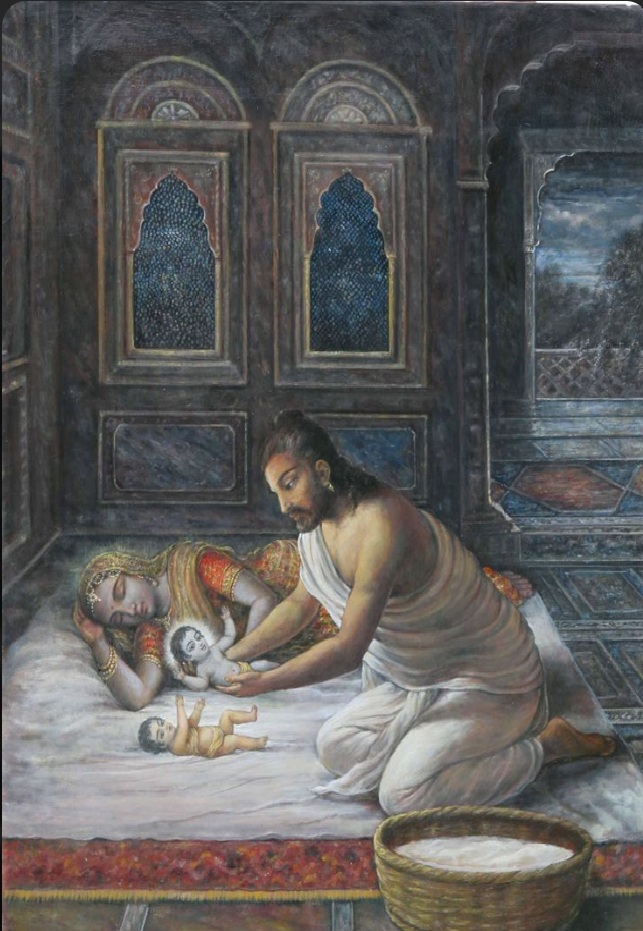
Raised by Nanda and Yashoda in the pastoral village of Gokul (and later Vrindavan), Krishna grew up among cowherds. He was mischievous, charming, and supremely divine. Tales of his childhood — stealing butter, charming the gopis (milkmaids), wrestling demons who came in disguised forms, and playing the flute — are celebrated as his lilas (divine pastimes). Each miracle and playful prank revealed both his human sweetness and his cosmic power.
Years later, Krishna would return to Mathura, confront Kamsa, and fulfill the prophecy by overthrowing the tyrant. But the story of the birth — the secret midnight escape, the river’s miracle, the exchange of infants — remains the seed from which all those later events grew.
23. WHY THE BIRTH MATTERS (SPIRITUAL MEANING)?
- Avatara of Vishnu- Krishna’s birth marks the appearance of the divine in human form to restore dharma and destroy adharma (unrighteousness). He is not merely a hero but an incarnation (avatara) with a cosmic purpose.
- Symbol of hope – Even in darkness (a prison, a tyrant’s cruelty) the divine can enter the world; Devaki and Vasudeva’s suffering is transformed by Grace.
- Intimacy of the divine- Krishna’s upbringing among ordinary villagers shows that the divine chooses intimacy, play, and love as means to engage with humanity — not only awe and wrath.
- Leela and teaching – The childhood stories are not trivial; they teach detachment, devotion (bhakti), and the playfulness of Reality.
24. WHY JANAMASHTAMI IS CELEBRATED?
- Divine Incarnation – Janmashtami celebrates the appearance of Lord Krishna as a divine incarnation sent to restore dharma. His life and teachings, especially through the Bhagavad Gita, are vital for spiritual upliftment.
- Victory of Good over Evil – Krishna’s birth was to eliminate evil forces, especially Kansa and other tyrants. His entire life symbolizes the triumph of righteousness.
- Source of Divine Wisdom – Lord Krishna is the philosopher-king whose words in the Gita are considered timeless wisdom. Janmashtami is an opportunity to study and reflect upon these teachings.
- Celebration of Bhakti (Devotion) – The festival emphasizes pure devotion. The love between Krishna and his devotees like Radha, the Gopis, and Meera Bai, represents the bond between the soul and the Divine.
25. REGIONAL VARIATIONS OF JANAMASHTAMI
- Mathura and Vrindavan – The birthplace and childhood home of Krishna witness massive celebrations with processions, dramas, and temple activities.
- Gujarat and Dwarka – In Dwarka, the kingdom established by Krishna, temples organize large-scale events with bhajans and abhishek.
- Maharashtra – Dahi Handi competitions are major public events where youths form Govinda teams to reach pots hung high above the streets.
- South India – Known as Sri Krishna Jayanthi, devotees draw small footprints leading into the house to welcome Krishna. Offerings of seedai and butter are made.
- Northeast India – In Manipur and Assam, Janmashtami is celebrated with traditional dance, music, and devotional programs.
26. FOODS AND OFFERINGS
- Chappan Bhog (56 Offerings) – Some temples and homes prepare 56 varieties of food items as offerings to Krishna.
- Favorite Foods of Krishna – Milk, butter, curd, sweets like peda, ladoo, and fruits are commonly offered.
- Distribution of Prasadam – After the midnight aarti, prasad (sanctified food) is distributed to all devotees.
27. CHILDREN AND JANAMASHTAMI
Children actively participate in the celebrations by dressing up as Lord Krishan and Radha. Schools conduct fancy dress competitions, storytelling, and crafts.
28. SPIRITUAL SIGNIFICANCE OF JANAMASHTAMI
- Birth in Darkness – Krishna was born at midnight, symbolizing the emergence of light in the darkness of ignorance.
- Liberation and Moksha – The festival reminds us of the ultimate spiritual goal—freedom from the cycle of birth and death through devotion and self-realization.
- Symbol of Inner Awakening – Krishna’s arrival in the prison cell symbolizes the awakening of divine consciousness in the heart imprisoned by ego and materialism.
29. TEACHINGS FROM LORD KRISHAN’S LIFE
- Perform your duty without attachment to the outcome (Karma Yoga).
- Remain balanced in success and failure.
- Surrender to God as the ultimate refuge.
- Love all beings and see divinity in everyone.
- Detach from ego and realize the eternal soul.
CONTEMPORARY RELEVANCE OF JANAMASHTAMI
In today’s fast-paced world, Krishna’s life and teachings offer immense guidance. The values of compassion, truth, duty, and detachment are timeless. Janmashtami connects individuals to their spiritual roots and strengthens cultural identity.
30. CONCLUSION
Janmashtami is more than a religious festival; it is a spiritual journey that reminds us of the divine presence in every aspect of life. The life of Lord Krishna teaches us to live with love, joy, courage, and wisdom. Through fasting, rituals, and devotion, Janmashtami becomes a powerful means to connect with the Divine within and around us. Celebrating the birth of Krishna is celebrating the birth of consciousness, dharma, and divine love in our lives.
31. WRAPPING UP
We hope this has tried to clear up some of the confusion about Janmashtami. First of all, you will have to know about the meaning of Janmashtami more than a religious festival; it is a spiritual journey that reminds us of the divine presence in every aspect of life. It is dedicated primarily to Lord Krishan. It commemorates the birth of Lord Krishna, the eighth avatar of Lord Vishnu, who is revered as one of the most powerful deities in the Hindu pantheon. Celebrated with intense devotion, elaborate rituals, fasting, and cultural festivities, Janmashtami falls on the Ashtami (eighth day) of the Krishna Paksha (waning moon) in the Hindu month of Bhadrapada (August–September).
In Hinduism, Krishna is not just a deity but also a friend, lover, philosopher, and guide. He is the speaker of the Bhagavad Gita, one of the most important scriptures in Hindu philosophy.
His teachings emphasize devotion (bhakti), duty (karma), and knowledge (jnana).
You still have any question, feel free to ask me via comments or via email.
Don`t forget to share what you like here on
Youtube,
Facebook, Instagram with your friends and family.
At DivineNewz, a spiritual and temples news related information providers, is working on the project to work for religion and information about the temples to share with you to bring new ideas about spiritual and religious world.
If you want article on any other religious specific topic then post the comment i will write on that topic.
Get in touch with DivineNews by contacting by divinenewz6@gmail.com/ For more information, please visit:
https://www.divinenewz.com
ARTICLE WRITTEN BY:
Divinenewz is a firm Working very proficiently for sharing the divinely knowledge, darshan and pilgrim details and many more in spiritual field. If you have any unique temple and divine place around the globe, then contact us at divinewisdom0608@gmail.com, divinenewz6@gmail.com, or
For more information, please visit:
https://www.divinenewz.com
Hathi Ghoda Palki Jai Kanhaiya Lal Ki
What are Spiritual Significances of Janmashtami?
1. Birth in Darkness: Krishna was born at midnight, symbolizing the emergence of light in the darkness of ignorance.
2. Liberation and Moksha : The festival reminds us of the ultimate spiritual goal—freedom from the cycle of birth and death through devotion and self-realization.
3. Symbol of Inner Awakening : Krishna’s arrival in the prison cell symbolizes the awakening of divine consciousness in the heart imprisoned by ego and materialism.
Teachings from Krishna’s Life
1. Perform your duty without attachment to the outcome (Karma Yoga).
2. Remain balanced in success and failure.
3. Surrender to God as the ultimate refuge.
4. Love all beings and see divinity in everyone.
Why Janmashtami is Celebrated?
Divine Incarnation: Janmashtami celebrates the appearance of Lord Krishna as a divine incarnation sent to restore dharma. His life and teachings, especially through the Bhagavad Gita, are vital for spiritual upliftment.
Victory of Good over Evil: Krishna’s birth was to eliminate evil forces, especially Kansa and other tyrants. His entire life symbolizes the triumph of righteousness.
What is meaning of Lord Krishan’s Flute?
Flute Represents the human heart emptied of ego, through which divine music (grace) flows.
What Lord Krishan’s Peacock Feather represents?
Peacock Feather Symbolizes beauty, knowledge, and spiritual magnificence.
What Lord Krishan’s Butter and Curd signifies?
Butter and Curd Signify purity and the essence of devotion.
What Lord Krishan’s Blue Color represents?
Lord Krishan’s Represents the infinite sky and cosmic nature of Krishna.


